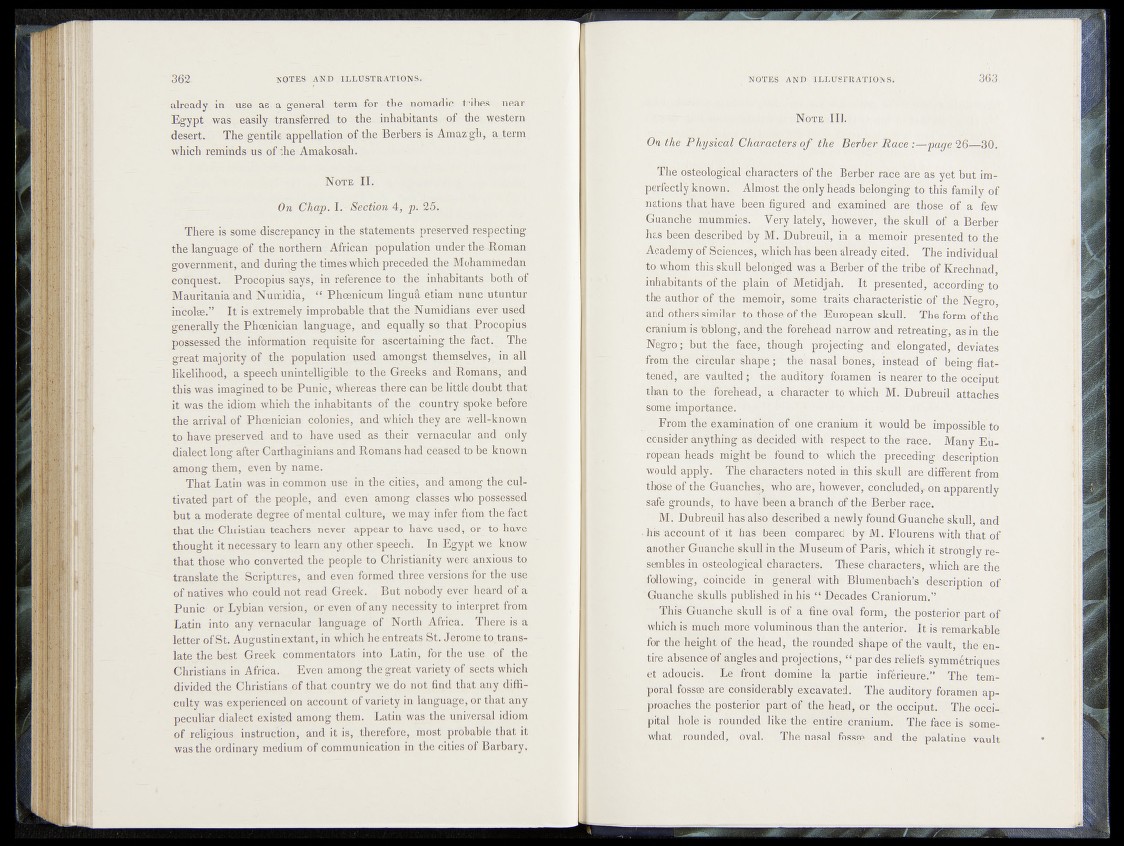
already in use as a general term for-the-'nomadic tribes near
Egypt was. easily transferred to the—inhabitants^iof the western-,
desert." The gentile rappellation of pie Berbers is Amazigh, a_term,
which reminds us of the Amakosah.
N ote II.
On Chap. I. - Section ^ p-£&.
There is some discrepancy in the statements preserved respecting
the language of the northern : African population under tbe-Roman
government,,and during the times which preceded the Mohammedan
conquest. Procopius says, in reference to. the inhabitants/bjjth of
Mauritania and Numidia, “ Phosnicum linguei etiarn nu|putuntur
iheolffi/’ It is extremely improbable that the* Numidians^vex usejd
generally the Phoenician language*. and equally so that^Vqea|)i|jS
possessed the information requisite for ascertaining the, facjt%1 The
great majority of the population: used-amongst themselvesjn all
likelihood, a speech unintelligible:,to.the Greeks and-Romang^und
this was imagined to be Punicj/wKSpeas there can bp little doubt that
it,was the idiom which the inhabitants of] the ' country spbkcbefore
the arrival of Phoenician colonies^ and which they^pe '^R-known
to have preserved and to have used as their ^vernaculars aod. .«.iffy
dialect long after Carthaginians and Romans had/geasqd. to^e.^kim^n
among them, even by name.
That Latin was in common use in the cities*t and among the cultivated
part of the people, and even among classes who possessed
but a moderate degree of mental culture^ we may infer from thefact
that the Christian teachers never appear to hdve used> (or^ to heye
thought it necessary to learn any other speech. In /Egypt we know
that those who converted the people to Christianity were anxious to
translate the Scriptures, and even formed three versions for the use
of natives who could not read Greek. But nobody ever heard of a
Punic- or Lybian version, or even of any necessity to interpret from
L a tin into any vernacular language of North Africa. There is a
letter ofSt. Augustin extant, in which he entreats St. Jerome to.trans-
late the best Greek commentators into Latin, for the use of the
Christians in Africa. Even among the great variety of sects which
divided the Christians,of that country we do not find that any difficulty
was experienced on account of variety in language, or that any
peculiar dialect existed among them. Latin was the universal idiom
of religious instruction, and it is, .therefore,, most probable that it
was the ordinary medium of communication in the cities of Barbary.
On^ihk^Physteal Cfuir^mbr^o f the BeWepiRace:—page 26—30.
The o sm l^ c a l characters of the Berber race are as yet but imperfectly
known. Almbsf the only hca/m!]belqngi mg to this family ol
liaupnsMK/f have been figured'' and/ éxaimried. are„ those of a few
Giianepl mumjmid|/TJ/"Vrery J ip y , however, the skull of a Berber
has been déscribedby ^ . Diibre^lm in |Wmeitroir' presented to the
Academyor^'i^Kef, which has been already cited. The individual
to whom this, skull belonged was a Berber of the tribe of Krechnad,
inhabitants of tp'e" plain ’of* Metidjah. It presented, according to
the author oLxhe memoir, some traits^Cnar’acteristic of the Negro,
and others similar fto those <ff the' European skull. The form of the
cranium is bblong, and the forehead narrow and retreating, as in the
N e g f^ b u t■ the, face, though' pli^pdting and elongated, deviates
fro mythe'circular shape; the! nasal bones5,'instead of being flatfef
tenéd?bate vaulted; the auditory fofambh-ris, Re&rer - to the occiput
than to the forehead,- a' character to Which' M. Dubreuil attaches
some' importance.1
From the examination of one cranium it* would be impossible to
consider anything as decided with respect to the' race. Many Eu-
ropèdn heads might- be found to which the preceding*, description
would apply. The’characters noted in this skull are different from
those of the Guanches,. who are, however, concluded^ on apparently
safe grounds, to have been a branch of'tfee Berber race.
M. Dubreuil has also described a newly found Guanche skull, and
his account or it has been compared ’by M. Flourens with that of
another Guanche skull in the Museum of Paris, which it strongly resembles
in ostèological characters. These characters, which are the
following, coincide itiv* general. with Blumenbach’s description of
Guanche skulls published in Mü u Decades CraniorumMsE
This Guanche skull is of a fine oval form, the posterior part of
which is much more voluminous than the anterior.s It is remarkable
for the height of the head, the rounded shape of the vault, the entire
absence of angles and projéctiöns* “ par des rebels. symmétriques
et adoucis. Le front doming la partie inférieuré.Él The temporal
fossae are considerably excavated. The auditory foramen approaches
the posterior part of the head, or the occiput. The occipital
' hole is rounded like the-entire cranium. Tfie face is somewhat
rounded, oval. The nasal fossae and the palatine vault